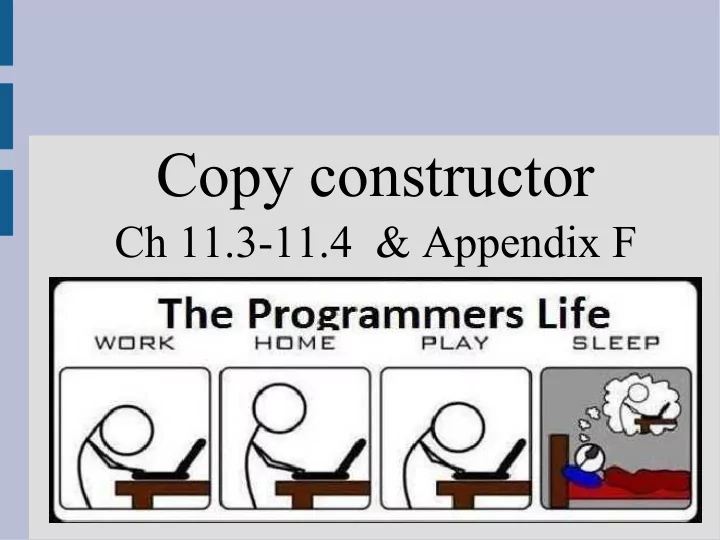

Copy constructor Ch 11.3-11.4 & Appendix F
object vs memory address An object is simply a box in memory and if you pass this into a function it makes a copy A memory address is where a box is located and if you pass this into a function, you can change the variable everywhere Memory address Object (box) arrays int, double, char, ... using & classes
const call-by-reference What is the difference between these two?
const call-by-reference What is the difference between these two? First one copies the values into x and y, thus these values exist in multiple places The second creates a link but does not let you modify the original (see: callByValue.cpp)
const call-by-reference Classes can be rather big, so in this case using const and '&' can save memory So a better way to write: ... would be: (function definition the same) In fact, without & creates a copy, which is a new object and thus runs a constructor
Copy constructor Remember this code from last time? What is output?
Copy constructor There is actually a built-in copier (much like there is a built-in default constructor) This built-in copier makes the boxes hold identical values... but is this good enough? Issues with copying? (Hint: recent material) (See: copyIssues.cpp)
Copy constructor Destructors are nice because they can automatically clean up memory However, you have to be careful that you do not cause things to delete twice This primarily happens when a copy is made poorly (a good copy is a “deep copy”) i.e. all pointers should not be shared between copies, you recursively remake the pointers
Copy constructor To avoid double deleting (crashes program) or multiple pointers looking at the same spot... We have to redefine the copy constructor if we use dynamic memory The copy constructor is another special constructor (same name as class): copy constructor
Copy constructor In a copy constructor the “const” is optional, but the call-by-reference is necessary (the '&') Why?
Copy constructor In a copy constructor the “const” is optional, but the call-by-reference is necessary (the '&') Why? If you did not use a &, you would make a copy which would call a copy constructor... which would make a copy... which would call a copy constructor... which crashes your computer! (See: copyConstructor.cpp)
Copy constructor You will use a copy when: 1. You use an '=' sign when declaring a class 2. You call-by-value a class as an input to a function (i.e. do not use &) 3. You return an inputted class to function (Third the compiler sometimes skips) (See: placesCopyConstructorRuns.cpp)
Copy constructor The most common class we have used is the “string” class Lines like this were running copy constuctor: It actually converts lines like this: constructor (copy)
Recommend
More recommend